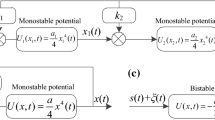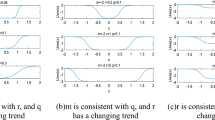Abstract
Bearing fault is the most likely to occur in mechanical fault, and stochastic resonance (SR), as a noise enhanced signal processing tool, can find mechanical faults as early as possible, so as to avoid larger problems. However, most of the existing research methods are based on the first-order Langevin equation. According to the previous studies of many scholars, the weak signal detection ability of the second-order system is better than that of the first-order system, and the coupled system also has better performance due to the addition of the control system. So, in order to detect the fault signal more easily, a second-order coupled tristable stochastic resonance system (SCTSR) based on the adaptive genetic algorithm (AGA) is proposed, it is an improvement on improving the first-order coupled tristable stochastic resonance system (FCTSR). First, based on the fourth-order Runge–Kutta algorithm (F-RK), the performances of monostable, bistable and tristable control systems to SCTSR are compared, it is verified that the monostable system has the best performance as SCTSR’s control system. Secondly, the equivalent potential function of SCTSR is derived, and the influences of each system parameters on it are researched. The output signal-to-noise ratio gain (SNRG) is chosen as a measure to verify that SCTSR’s performance is better than that of FCTSR, and the influences of parameters on SNRG are discussed. SCTSR and FCTSR are used to detect low-, high- and multi-frequency cosine signals combined with AGA. The simulation results are compared with the wavelet transform method, which proves the performance superiority of SR, and also prove that SCTSR is easier to detect weak signals and has a stronger de-noising ability. Finally, SCTSR and FCTSR are applied in bearing fault detection under Gaussian white noise and trichotomous noise. The results also prove that SCTSR can get larger peaks and SNRG, and it is easier to detect fault signals. This proves that SCTSR’s performance is superior that of other methods in bearing fault detection, and has better engineering application value.



































Similar content being viewed by others
Data availability
The datasets generated and analyzed during the current study are available from the corresponding author on reasonable request.
References
Abdullah, G., Yilmaz, U., Ihsan, P.: A weak signal detection application based on hyperchaotic lorenz system[J]. Teh. Vjesn. Tech. Gaz. 25(3), 701–708 (2018)
Huaitao, S., Yangyang, L., Xiaotiao, B., et al.: A two-stage sound-vibration signal fusion method for weak fault detection in rolling bearing systems[J]. Mech. Syst. Signal Process. 172, 109012 (2022)
Gupta, V., Mittal, M., Mittal, V., et al.: A critical review of feature extraction techniques for ECG signal analysis[J]. J. Inst. Eng. India Ser. B 102(5), 1049–1060 (2021)
Gupta, V., Mittal, M.: A comparison of ECG signal pre-processing using FrFT, FrWT and IPCA for improved analysis[J]. Innov. Res. Biomed. 40(3), 145–156 (2019)
Jihong, Y., Lei, L.: Improved Hilbert-Huang transform based weak signal detection methodology and its application on incipient fault diagnosis and ECG signal analysis[J]. Signal Process. 98, 74–87 (2014)
Gupta, V., Mittal, M., Mittal, V.: Chaos theory: an emerging tool for arrhythmia detection[J]. Sens. Imaging Contin. Subsurf. Sens. Technol. Appl. 21(3), 10–31 (2020)
Siqi, G., Shunming, Li., Houming, W., et al.: Multi-frequency weak signal detection based on wavelet transform and parameter selection of bistable stochastic resonance model[J]. J. Vib. Eng. Technol. 9(5), 887–906 (2021)
Hanfang, D., Yanxue, W.: Fault diagnosis of rotating mechanical bearing based on adaptive noise-complete ensemble empirical modal decomposition and time-reallocated multisynchronous compression transform[J]. J. Phys Conf. Ser. 1820(1), 012114 (2021)
Chenjing, L., Xuemei, X., Yipeng, D., et al.: Weak photoacoustic signal detection based on the differential duffing oscillator[J]. Int. J. Mod. Phys. B 32(9), 1850103 (2018)
Gupta, V., Mittal, M.: QRS Complex detection using STFT, Chaos analysis, and PCA in standard and real-time ECG databases[J]. J. Inst. Eng. India Ser. B 100(5), 489–497 (2019)
Gupta, V., Mittal, M., Mittal, V.: Chaos theory and ARTFA: emerging tools for interpreting ECG signals to diagnose cardiac arrhythmias[J]. Wirel. Pers. Commun. 118(4), 3615–3646 (2021)
Gupta, V., Mittal, M., Mittal, V.: R-peak detection based chaos analysis of ECG signal[J]. Analog Integr. Circ. Signal Process. 102(3), 479–490 (2020)
Gupta, V., Mittal, M., Mittal, V.: R-peak detection using Chaos analysis in standard and real time ECG databases[J]. IRBM 40(6), 341–354 (2019)
Kumar, S., Kumar Jha, R.: Weak signal detection using stochastic resonance with approximated fractional integrator[J]. Circuits Syst. Signal Process. 38(3), 1157–1178 (2019)
Benzi, R., Sutera, A., et al.: The mechanism of stochastic resonance[J]. J. Phys. A Math. Gen. 14(11), 453–457 (1981)
Senthilselvi, A., Duela, J., Shiny Prabavathi, R., et al.: Performance evaluation of adaptive neuro fuzzy system (ANFIS) over fuzzy inference system (FIS) with optimization algorithm in de-noising of images from salt and pepper noise[J]. J. Ambient Intell. Humaniz. Comput. 10, 20–21 (2021). https://doi.org/10.1007/s12652-021-03024-z
Emanuel, M., Miguel, R.-G., Manuel, C., et al.: Coherence resonance and stochastic resonance in an excitable semiconductor superlattice[J]. Phys. Rev. Lett. 121(8), 086805 (2018)
Yilmaz, E., Uzuntarla, M., Ozer, M., et al.: Stochastic resonance in hybrid scale-free neuronal networks[J]. Phys. A 392(22), 5735–5741 (2013)
López, C., WeiSiliang, Z.L., et al.: Stochastic resonance in an underdamped system with FitzHug-Nagumo potential for weak signal detection[J]. J. Sound Vib. 411, 34–46 (2017)
Jimeng, Li., Xiangdong, W., Zhixin, Li., et al.: Stochastic resonance in cascaded monostable systems with double feedback and its application in rolling bearing fault feature extraction[J]. Nonlinear Dyn. 104(2), 971–988 (2021)
Gang, Z., Yujie, Z., Lifang, He.: Tri-stable stochastic resonance coupling system driven by dual-input signals and its application in bearing fault detection[J]. Phys. Scr. 97(4), 045202 (2022)
Jimeng, L., Jinfeng, Z., Ming, L., et al.: A novel adaptive stochastic resonance method based on coupling bistable systems and its application in rolling bearing fault diagnosis[J]. Mech. Syst. Signal Process. 114, 128–145 (2019)
Shuai, Z., Peiming, S., Dongying, H.: A novel mechanical fault signal feature extraction method based on unsaturated piecewise tri-stable stochastic resonance[J]. Measurement 168, 8374 (2020)
Yaguo, L., Zijian, Q., Xuefang, X., et al.: An underdamped stochastic resonance method with stable-state matching for incipient fault diagnosis of rolling element bearings[J]. Mech. Syst. Signal Process. 94, 148–164 (2017)
Zijian, Q., Jian, L., Xin, Ma., et al.: Double stochastic resonance induced by varying potential-well depth and width[J]. J. Frankl. Inst. 358(3), 2194–2211 (2021)
Yuangen, Y.: Time-varying coupling-induced logical stochastic resonance in a periodically driven coupled bistable system[J]. Chin. Phys. B 30(6), 195–199 (2021)
Yonggang, L., Zhihui, L., Shengbo, F., et al.: Large parameter stochastic resonance of two-dimensional duffing oscillator and its application on weak signal detection[J]. Acta Phys. Sin. 61(23), 230502 (2012)
Park, H.J., Baek, S.K., Kim, B.J.: Stochastic resonance in the two-dimensional q-state clock models[J]. Phys. Rev. E Stat. Nonlinear Soft Matter Phys. 89(3), 032137 (2014)
Batra, V.P., Chopra, R.: Stochastic resonance in two coupled fractional oscillators with potential and coupling parameters subjected to quadratic asymmetric dichotomous noise[J]. Phys. A Stat. Mech. Appl. 561, 125148 (2020)
Siliang, Lu., Qingbo, He., Fanrang, K.: Effects of underdamped step-varying second-order stochastic resonance for weak signal detection[J]. Digit. Signal Process. 36, 93–103 (2015)
Zijian, Q., Elhattab, A., Xuedao, S., et al.: A second-order stochastic resonance method enhanced by fractional-order derivative for mechanical fault detection[J]. Nonlinear Dyn. 106(1), 707–723 (2021)
Zhihui, L., Jiansheng, L., Haitao, Z., et al.: Multi-parameter-adjusting stochastic resonance in a standard tristable system and its application in incipient fault diagnosis[J]. Nonlinear Dyn. 96(3), 2069–2085 (2019)
Chengjin, W., Jianhua, Y., Sanjuán, M.A.F., et al.: Stochastic resonance induced by an unknown linear frequency modulated signal in a strong noise background[J]. Chaos 30(4), 043128 (2020)
Xuanang, C., Peijun, G.: Path planning and control of soccer robot based on genetic algorithm[J]. J. Ambient Intell. Humaniz. Comput. 11(12), 6177–6186 (2020)
Pratap-Kumar, B., Sugata, G.: Evolving bijective S-boxes using hybrid adaptive genetic algorithm with optimal cryptographic properties[J]. J. Ambient Intell. Humaniz. Comput. (2021). https://doi.org/10.1007/s12652-021-03392-6
Cristian, L., ÁngelSiliang, N.L., et al.: Hidden markov model based stochastic resonance and its application to bearing fault diagnosis[J]. J. Sound Vib. 528, 116890 (2022)
Rongling, L., Liang, Y., Honglei, Q., et al.: Trichotomous noise induced stochastic resonance in a linear system[J]. Nonlinear Dyn. 69(3), 1423–1427 (2012)
Siliang, L., Yunsheng, S., Jiwen, Z., et al.: Research on bearing fault diagnosis method based on two-dimensional complementary stochastic resonance[J]. Vib. Shock 37(4), 7–12 (2018)
Biao, W., Yaguo, L., Naipeng, L., et al.: A hybrid prognostics approach for estimating remaining useful life of rolling element bearings[J]. IEEE Trans. Reliab. 69(1), 401–412 (2020)
Acknowledgements
This work is supported by the National Natural Science Foundation of China (No. 61771085), Research Project of Chongqing Educational Commission (KJ1600407, KJQN201900601) and Natural Science Foundation of Chongqing (cstc2021jcyj-msxmX0836). The authors also would like to thank the anonymous reviewers for their valuable comments and suggestions. They help us to improve the work comparatively and fundamentally.
Funding
The authors have not disclosed any funding.
Author information
Authors and Affiliations
Corresponding author
Ethics declarations
Conflict of interest
The authors declare that they have no conflict of interest.
Additional information
Publisher's Note
Springer Nature remains neutral with regard to jurisdictional claims in published maps and institutional affiliations.
Rights and permissions
Springer Nature or its licensor (e.g. a society or other partner) holds exclusive rights to this article under a publishing agreement with the author(s) or other rightsholder(s); author self-archiving of the accepted manuscript version of this article is solely governed by the terms of such publishing agreement and applicable law.
About this article
Cite this article
Zhang, G., Zeng, Y. & Zhang, T. Second-order coupled tristable stochastic resonance and its application in bearing fault detection under different noises. Nonlinear Dyn 111, 8987–9009 (2023). https://doi.org/10.1007/s11071-023-08303-2
Received:
Accepted:
Published:
Issue Date:
DOI: https://doi.org/10.1007/s11071-023-08303-2




